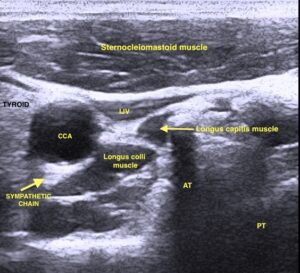Stellate ganglion block (SGB) is used for the treatment of many medical conditions including complex regional pain syndrome and peripheral vascular disease. Historically, the anesthetic has been injected at the C6 or C7 vertebral level with the Chassignac’s tubercle, the cricoid cartilage, and the carotid artery serving as the anatomic landmarks to the procedure.
Sonographic visualisation of sympathetic chain at C6 vertebral level. You can appreciate posterior (PT) and anterior (AT) tubercle of C6 transverse process. You can see also carotid artery (CCA) and internal jugular vein (IJV) partially compressed by probe pressure.
Anatomy and Physiology
The sympathetic fibers for the head, neck, heart, and superior limbs arise from the first thoracic segments, ascend through the sympathetic chain, and synapse in the superior, middle, and inferior cervical ganglions. The stellate ganglion is present in 80% of the general population and is composed of the inferior cervical ganglion and the first thoracic ganglion fusion. It lies anterior to the neck of the first rib and extends to the inferior aspect of the transverse process of C7. Usually, it is located medial or posterior to the vertebral artery close to the dome of the pleura.
-
If the inferior cervical ganglion and first thoracic ganglion are not fused, the stellate ganglion refers to the inferior cervical ganglion located adjacent to the anterior C7 tubercle.
-
The preganglionic fibers of the stellate ganglion continue to travel through the cervical sympathetic chain, and the postganglionic fibers provide the sympathetic innervation of the upper limbs.
- SGB with local aesthetic exert their effect both on preganglionic and postganglionic fibres.
Indications
The pain relieved by sympathetic block is classified as sympathetically mediated pain (SMP) that consists of abnormal connections between sympathetic and sensory nervous systems.
The therapeutic effects of SGB are due to the block in neural connections in its region of innervation, the improvement in the blood supply of the region, the reduction of adrenal hormones plasma concentration. SGB can be used in medical conditions like post-traumatic stress disorder or a cluster headache based on its sedative effect. SGB can be used as a diagnostic tool to confirm SMP.
-
Complex regional pain syndrome of the head and upper limbs
-
Peripheral vascular disease
-
Upper extremity embolism
-
Postherpetic neuralgia
-
Chronic post-surgical pain
-
Hyperhidrosis
-
Raynaud disease
-
Scleroderma
-
Orofacial pain
-
Phantom limb
-
Atypical chest pain
-
A cluster or a vascular headache
-
Post-traumatic stress disorder
-
Meniere syndrome
-
Intractable angina
-
Refractory cardiac arrhythmias
Contraindications to the procedure may include:
-
Recent myocardial infarction
-
Anti-coagulated patients or coagulopathy (evaluate risk/benefit ratio)
-
Glaucoma
-
Severe emphysema
Technique
Ultrasound-Guided Technique
The patient is supine with the neck slightly extended and the head slightly rotated contralaterally to the approached side. The site is cleaned and draped, and the transducer is placed perpendicular to the tracheal axis at the cricoid cartilage and is moved inferiorly until the superior aspect of the thyroid gland is visualized. Later, the transducer should be relocated laterally to visualize the anterior aspect of the Chassaignac’s tubercle on the C6 transverse process. The carotid artery, internal jugular vein, thyroid gland, trachea, Longus colli, and Longus capitis muscle, prevertebral fascia, the root of C6 spinal nerve, and transverse process of C6 can be identified (see Figure 1). Color Doppler should be used to detect the position of the vessels. With an in-plane approach, the needle is placed beside the trachea with a lateral to medial direction. The tip must reach the prevertebral fascia of the Longus colli muscle located between the posterior aspect of the carotid artery and the tip of the C6 anterior tubercle. Local anaesthetic is injected, and the diffusion of the injectate is seen in real-time.
Clinical Significance
A sympathetic block as SGB can be useful in the diagnosis and treatment of sympathetically mediated pain in the upper limb, head, and neck regions; it can also be used in the treatment of medical conditions as post-traumatic stress disorder (PTSD), cluster headache, or intractable angina.
